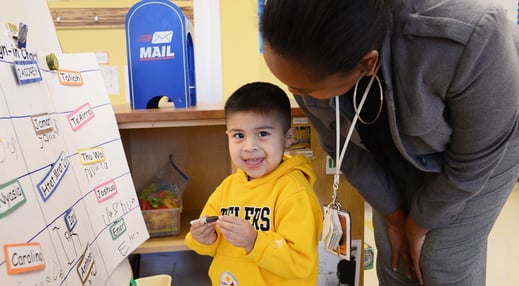
One of the best things about teaching is having a fresh start every morning. Greeting your students plays an important part in setting the tone of your classroom. I like to think that, as teachers, we get a chance to make a good first impression each day. Let's take a moment to consider the impact greetings can have on children, not only at the beginning of the school day but throughout the day as well.
Why are greetings important?
Educator-child interactions are at the heart of every classroom. Greetings let your children know that you care about them not only as students but as people too. They're also a great way to check in with your students as they enter the classroom. Are they smiling? Do they seem distracted? Taking the time to greet your students gives you a chance to notice things like this and the ability to adjust to their emotional needs.
Not to mention, leaving behind the events of the morning, or yesterday, and allowing the students to have a fresh start each day lets you to cultivate hope and optimism in your classroom. This allows your students to have open minds, and a willingness to try new and challenging tasks. When you build a relationship with your students, they won't let a bad moment they had yesterday (or in an earlier class) affect how they're learning in the here and now.
Now that we've discussed why greeting students matters, here are 5 easy ways you can greet your students in the morning and throughout the day!
1. Be prepared
Have things ready for the students to do without your assistance so you can greet them and give them individual attention as they arrive. Set up engaging activities on tables and in centers with materials you know they will enjoy, especially if you work in a setting with younger students and they are having difficulty separating. For older students, be ready before the bell rings so that you can greet them as they arrive, instead of putting the finishing touches on your preparations for the day.
2. Establish arrival and greeting routines
These kinds of routines establish trust and a feeling of safety in the classroom. When students know there are specific jobs to do when they arrive (taking care of personal belongings, washing hands, checking in, making lunch choices) they quickly get into the flow of the day. Special things they do with you—a secret handshake, greeting song or poem, an interesting quote or thought-provoking question/image on the board to spark discussion—allow them to re-establish connections with you and set the tone for the day. These types of activities are especially important for students who have connection deficits in their lives and relationships outside of school.
3. Pause and Connect
Even older students who change classes throughout the day can benefit from time to pause and connect about how their day is going when they arrive in your classroom. They may need time to decompress from a stressful morning at home or a challenging test in an earlier class. They may want to take a few moments to talk about things happening in the world and they may not have another adult willing to take the time to hear their perspectives on things. These few moments don’t need to take away from the other content you need to cover that day. In fact, a few moments to pause and connect will likely help them to shift gears and be ready to take on the new material you have prepared.
4. Be at their level and ready when they enter the room
With younger students you can be seated in a chair at their level, and with older students you can be standing, ready, and welcoming them in. Greeting them with a big smile and an, "I'm so glad you're here today!" at their level communicates warmth and respect. This is especially important for students who had a rough day the day before. They may need a fresh start!
5. Be available to parents in a variety of ways
Greeting students doesn't have to mean greeting just them. In many settings, parents drop off and pick up their children directly from our care. In these situations, communicate to parents at the beginning of the year (and each morning) that you have a moment to chat and check-in. However, if they need to have a more involved conversation you'll want to give them your full attention. Make sure parents have other ways to communicate with you—a personal communication log, email, sticky notes requesting a phone call later with a good time to call—and encourage them to use them! That way you can focus on greeting your students.
Each day is a new chance to greet your students and let you know that you're here for them. Whether it’s the first day of school or the 101st day of school, greeting students with that message in mind will firmly establish for everyone the importance of both the relationship and of learning in the classroom together.

